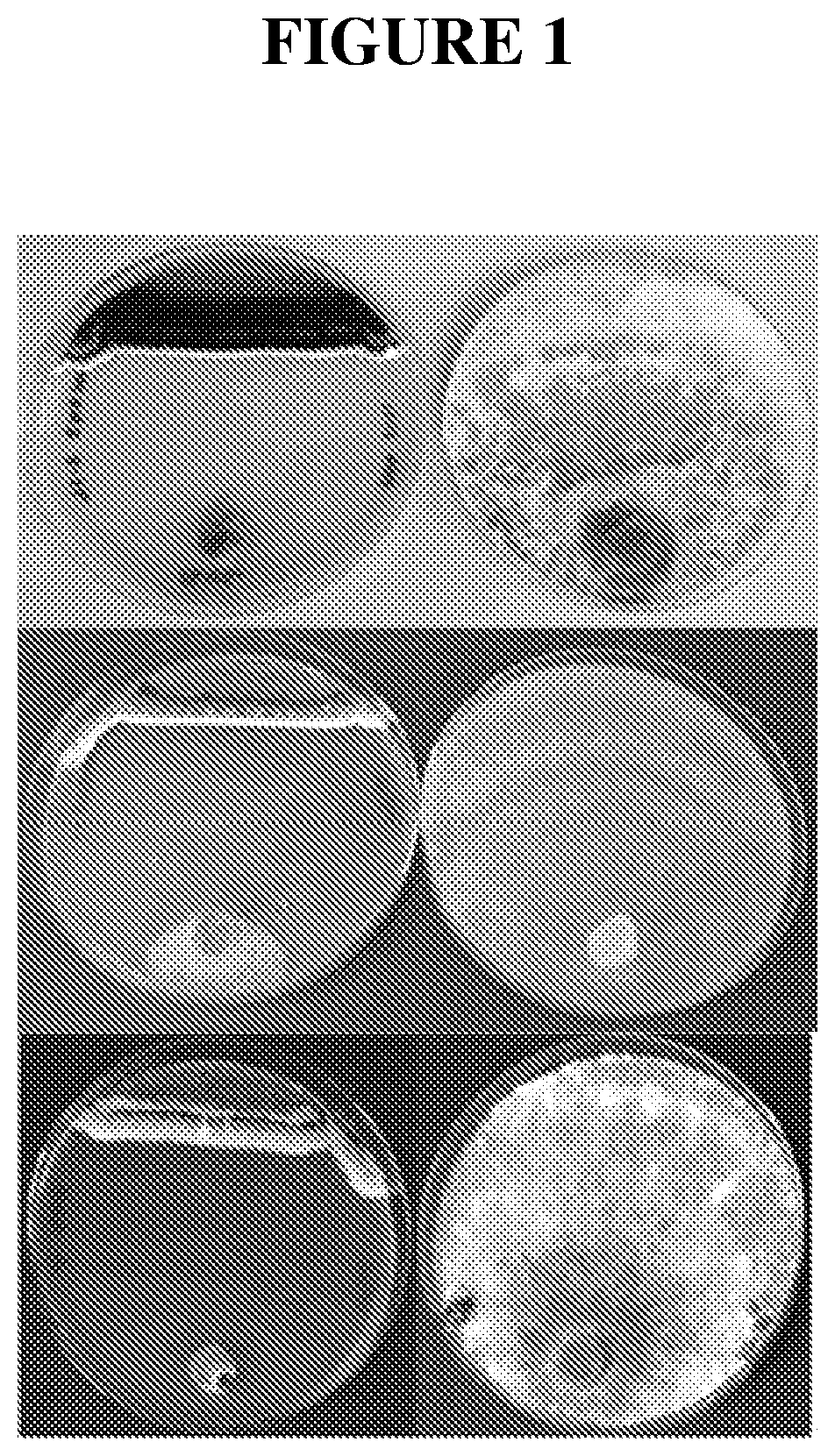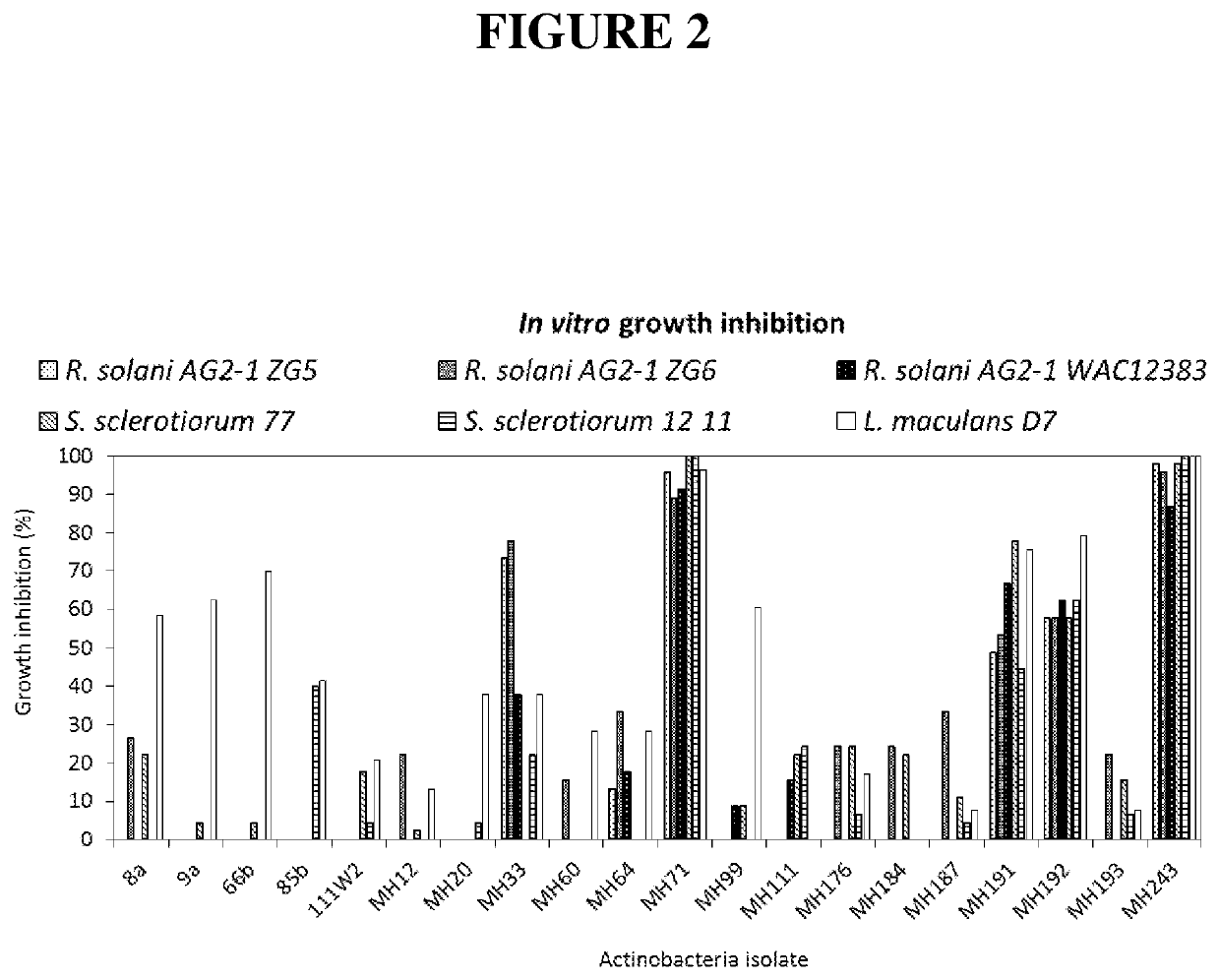Methods and compositions for the biological control of plant pathogens
a technology of pathogens and compositions, applied in the field of new actinobacteria, can solve the problems of affecting the survival rate of plants, so as to reduce the susceptibility of plants and reduce the growth of pathogenic organisms. or inhibiting
- Summary
- Abstract
- Description
- Claims
- Application Information
AI Technical Summary
Benefits of technology
Problems solved by technology
Method used
Image
Examples
example 1
Collection and Isolation of Endophytic Actinobacteria
[0162]Actinobacteria were isolated from the roots of healthy wheat plants in the Western Australia wheat belt. Plants were selected from areas of paddocks that had shown anecdotal evidence of superior growth and yield, and less disease compared to other areas on the same farm with no obvious environmental or climatic explanation. Plants were sampled at random from these areas by hand picking to collect roots as well as shoots. Upon return to the laboratory, plant roots were surface sterilised by washing roots in 99% ethanol, followed by bleach and again in ethanol after which the roots were held in a flame to burn off any ethanol remaining. The roots were then cut aseptically to expose microorganisms inside the plant. The exposed microorganisms were plated on agar medium selective for Actinobacteria. This was a low nutrient medium (mineral salts with a small amount of glucose). The plates were incubated at 28° C. for up to 6 week...
example 2
Direct Suppression of Fungal Pathogens by Actinobacteria Isolates
Antifungal Metabolite Production—In Vitro Assays
[0171]In vitro (agar plate) assays were used as an initial screen to assess the suppression of fungal pathogen growth due to bioactive compound production (e.g. metabolites) by the Actinobacteria isolates. Agar plate inhibition assays were conducted by co-inoculating the test organism (Actinobacteria) and the fungal pathogen at opposite ends of a nutrient agar plate. A second plate was inoculated at one end with the fungal pathogen alone as a control. The plates were incubated at 28° C. in the dark until the control plate was completely covered by the pathogen. The level of inhibition of the fungal pathogen by the Actinobacteria was measured as the distance between the growing front of the test organism and the fungus on the day that the fungus had completely covered the control plate (examples shown in FIG. 1). Percentage inhibition was then calculated relative to the di...
example 3
Biocontrol of Diseases in Wheat Plants
Rhizoctonia and Pythium
[0173]Initially glasshouse experiments with each of these diseases focused on plant growth in 4-week old wheat plants inoculated with and without the disease in question in the presence or absence of the test Actinobacteria isolate (applied as a seed coat with xanthan gum for treating root diseases). Differences in plant biomass were recorded as a measure of disease protection. Compared with disease-only controls, isolate MH71 increased plant biomass in the presence Rhizoctonia or Pythium (e.g. FIG. 3).
Fusarium Crown Rot
[0174]In small plant assays (soil free), surface sterilised wheat (Triticum aestivum) seeds were coated with spores of test Actinobacteria. Seeds were then wrapped in a wet paper towel which was placed in a beaker and kept moist. Once the wheat plants protruded from the top of the paper rolls, 2 ml of a 106 / ml spore suspension of the test pathogen was introduced. Plants were scored for disease severity and...
PUM
| Property | Measurement | Unit |
|---|---|---|
| pH | aaaaa | aaaaa |
| temperatures | aaaaa | aaaaa |
| temperature | aaaaa | aaaaa |
Abstract
Description
Claims
Application Information
 Login to View More
Login to View More - R&D
- Intellectual Property
- Life Sciences
- Materials
- Tech Scout
- Unparalleled Data Quality
- Higher Quality Content
- 60% Fewer Hallucinations
Browse by: Latest US Patents, China's latest patents, Technical Efficacy Thesaurus, Application Domain, Technology Topic, Popular Technical Reports.
© 2025 PatSnap. All rights reserved.Legal|Privacy policy|Modern Slavery Act Transparency Statement|Sitemap|About US| Contact US: help@patsnap.com



